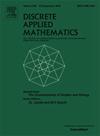Incorporating predictions in online graph coloring algorithms
IF 1
3区 数学
Q3 MATHEMATICS, APPLIED
引用次数: 0
Abstract
We focus on learning augmented algorithms for the online graph coloring problem. We consider incorporating predictions in such algorithms to improve their performance. We apply this strategy in particular to the well-known greedy online graph coloring algorithm FirstFit. Although FirstFit is known to perform poorly in the worst case, we are able to establish a relationship between the structure of the input graph that is revealed online and the number of colors that FirstFit uses for . Based on this relationship, we propose an online coloring algorithm FirstFitPredictions that extends FirstFit while making use of machine learned predictions. We show that FirstFitPredictions is both consistent and smooth. Moreover, we develop a novel framework for combining online algorithms at runtime specifically for the online graph coloring problem. Finally, we show how this framework can be used to robustify FirstFitPredictions by combining it with any classical online coloring algorithm (that disregards the predictions).
结合在线图着色算法的预测
我们专注于学习在线图着色问题的增强算法。我们考虑在这些算法中加入预测以提高它们的性能。我们特别将此策略应用于著名的贪婪在线图着色算法FirstFit。虽然已知FirstFit在最坏的情况下表现不佳,但我们能够在在线显示的输入图G的结构和FirstFit为G使用的颜色数量之间建立关系。基于这种关系,我们提出了一种在线着色算法FirstFitPredictions,它在使用机器学习预测的同时扩展了FirstFit。我们证明了FirstFitPredictions既一致又平滑。此外,我们开发了一个新的框架,用于在运行时结合在线算法,特别是针对在线图着色问题。最后,我们将展示如何使用该框架通过将其与任何经典的在线着色算法(忽略预测)相结合来增强FirstFitPredictions。
本文章由计算机程序翻译,如有差异,请以英文原文为准。
求助全文
约1分钟内获得全文
求助全文
来源期刊

Discrete Applied Mathematics
数学-应用数学
CiteScore
2.30
自引率
9.10%
发文量
422
审稿时长
4.5 months
期刊介绍:
The aim of Discrete Applied Mathematics is to bring together research papers in different areas of algorithmic and applicable discrete mathematics as well as applications of combinatorial mathematics to informatics and various areas of science and technology. Contributions presented to the journal can be research papers, short notes, surveys, and possibly research problems. The "Communications" section will be devoted to the fastest possible publication of recent research results that are checked and recommended for publication by a member of the Editorial Board. The journal will also publish a limited number of book announcements as well as proceedings of conferences. These proceedings will be fully refereed and adhere to the normal standards of the journal.
Potential authors are advised to view the journal and the open calls-for-papers of special issues before submitting their manuscripts. Only high-quality, original work that is within the scope of the journal or the targeted special issue will be considered.
 求助内容:
求助内容: 应助结果提醒方式:
应助结果提醒方式:


